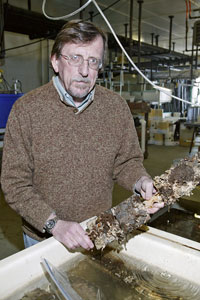Researcher Studies Decrease
In Native Marine Organisms
 |
| Robert Whitlatch, professor of marine sciences, works in his lab with sea squirts. He is studying how climate change and land use patterns affect marine species. |
|
Photo by Tina Covensky |
The past 20 years have seen a dramatic decrease in the numbers of native organisms in Connecticut’s coastal waters. At the same time, invasive non-native species – sea squirts and sponges from the Philippines and the Gulf of Mexico among them – have increased in abundance. In some places they carpet the rocky ocean floor, smothering shellfish beds and overrunning other native organisms.
Robert Whitlatch, a professor of marine sciences, believes this significant decline in environmental quality can only be explained by a combination of factors.
“Our coastal environments are affected by many different kinds of insults,” he says.
With the help of a U.S. Environmental Protection Agency grant of $560,000, Whitlatch is looking at how the combination of three “insults” in particular – climate change, land use patterns, and the presence of invasive species – are interacting to affect marine life. Ultimately, this research will equip coastal zone managers with new insights and tools with which to assess and address environmental quality.
For more than a year, Whitlatch and his team of graduate and undergraduate students have been conducting a series of experiments in the laboratory and at 12 sites along the Connecticut coast. Their work reveals that both climate change and human activity make conditions more favorable to invaders.
He notes that over the past quarter of a century, winter water temperatures have increased about 1.5 degrees centigrade (approximately 5 degrees Fahrenheit). Yet this modest change in climate cannot by itself account for a seven-fold increase in the abundance of non-native species and a four-fold decrease in the abundance of native marine life.
That’s where land use patterns come in. Drawn here by warmer water temperatures, these invaders seem to gain a foothold and flourish in areas where human activity has already degraded environmental quality and reduced the biodiversity of native species. Thus the more industrial and commercial areas of Connecticut’s coast are more susceptible to invasion than those with undeveloped tracts of woodlands.
Whitlatch is using reciprocal transfer techniques in his experiments. In some, small communities of organisms from healthy coastal environments are transplanted to sites that are heavily stressed by human activity. “If you move these assemblages of organisms that are developed in more pristine areas into degraded environments, all of a sudden you see the process of reduction in species number. And all of a sudden you see more invaders come in,” says Whitlatch. “It’s consistent with our previous work that in degraded environments species diversity is reduced and then these invaders become dominant.”
When groups of organisms from degraded environments are placed in more pristine environments, the opposite occurs: There is an increase in the quantity and variety of native species and a decrease in the number of invaders. “They favor areas that are stressed,” says Whitlatch of the invasive species. “So if you reduce those stress levels, the natural biodiversity will help to resist an invasion.”
In order to look at the effects of climate change, Whitlatch is also using reciprocal transfers with organisms that have been exposed to warmer-than-ambient water temperatures in the laboratory.
While preventing invasions is key to the survival of native fauna, Whitlatch points out it also has benefits for humans. “These invaders can have potential impacts on economically important species, like shellfish.” They can also clog water intakes and foul boat bottoms, wharves, and other structures, incurring clean-up costs.
Whitlatch’s findings will be used to develop a multi-tiered computer-based model that will characterize the complex interaction of all three stressors, providing resource and coastal zone managers with critical insights into the dynamics of marine life.
“We are just beginning that phase of the work,” he says.
While the model’s projections will be a valuable tool for long-term environmental management, Whitlatch believes that the invasive species can be a quick litmus test for environmental stress. A colony of sea squirts native to Southern Europe, for example, may be viewed as a red flag signaling that the area is potentially threatened.
Says Whitlatch, “With (human) population growth, there’s more and more pressure on the coastal environments. We need to develop ways of rapidly assessing how those environments are responding to added human pressure in a time when we have climate change.”
Whitlatch says the multi-stressor approach and its modeling component may be applicable to areas other than the stretch of coast between the Rhode Island border and New Haven harbor, where the UConn team has focused its research.
“Our goal is to develop an approach that can be used nationally,” he says. “We’re using New England as the test bed. I would hope that the results could be translated to a broader scale.”

